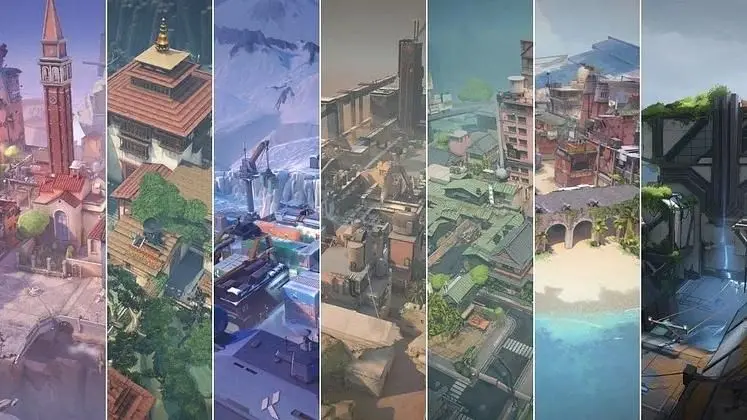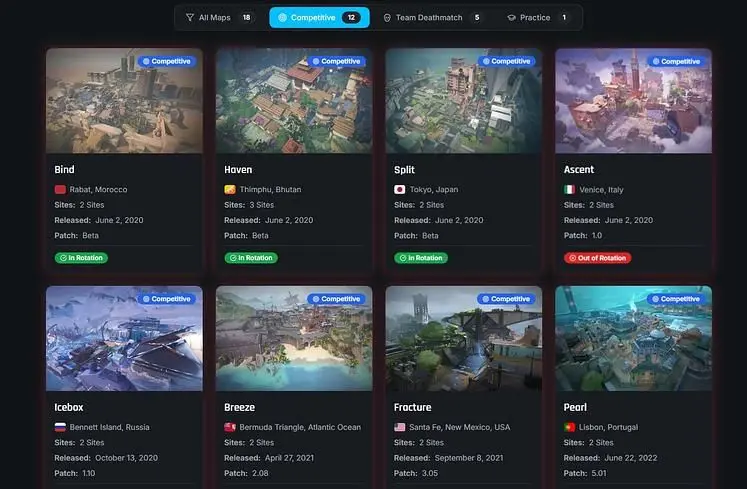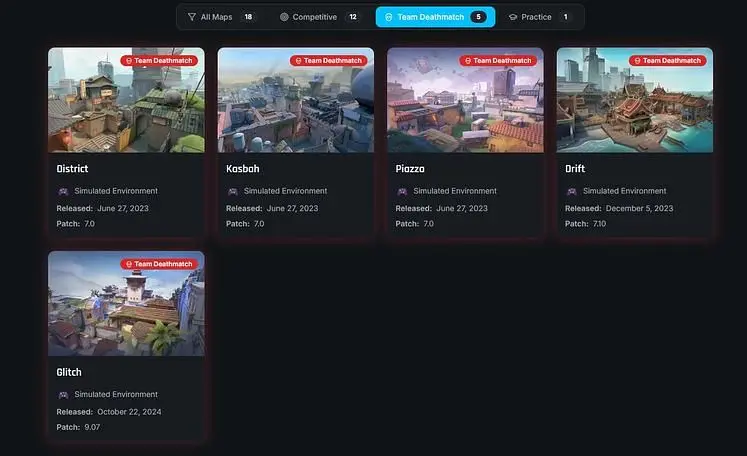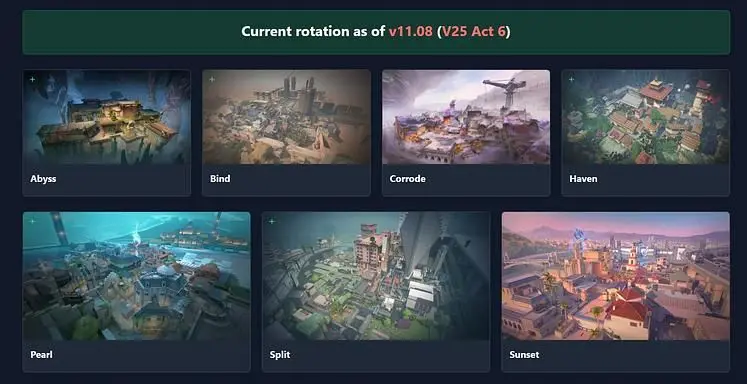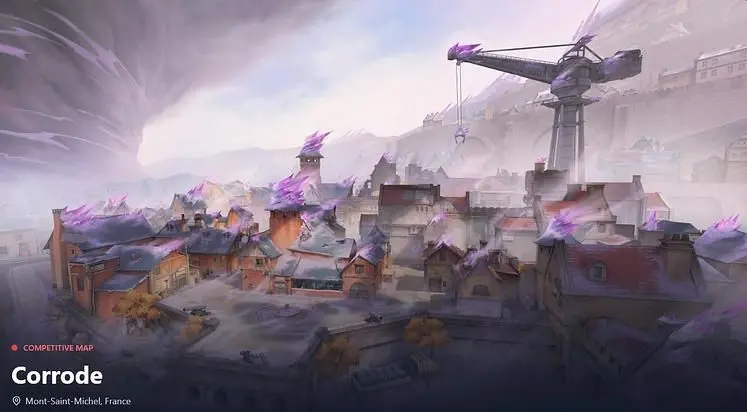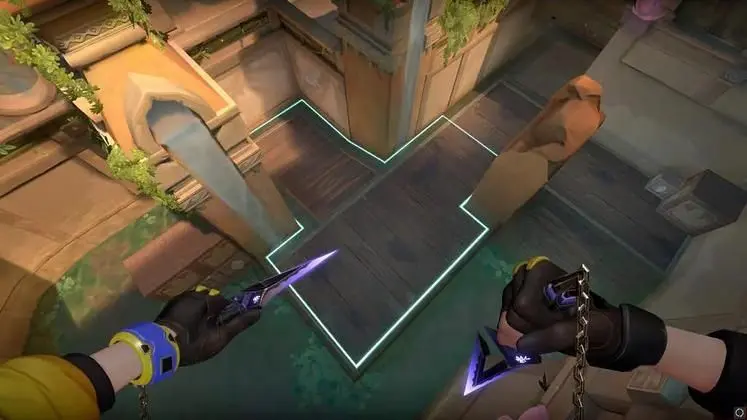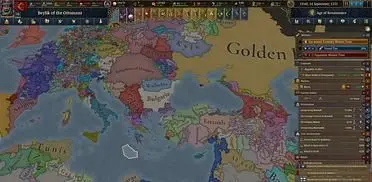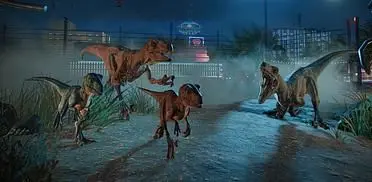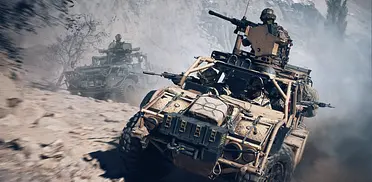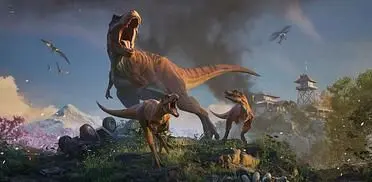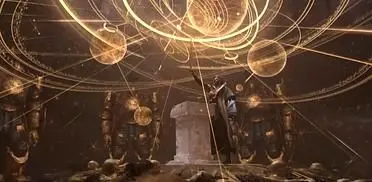Mastering Valorant Maps has become more crucial than ever for players looking to gain a competitive edge in 2025. The current landscape presents both opportunities and challenges you need to understand not just individual map layouts, but how Riot’s rotation system affects which battlegrounds you’ll actually encounter.
Valorant currently features 12 standard maps, but only seven remain active in competitive play at any given time. The active competitive rotation includes Abyss, Ascent, Bind, Corrode, Haven, Lotus, and Sunset. Beyond these standard maps, the game offers five dedicated Team Deathmatch arenas and one training facility. Map popularity shows clear patterns Bind, Haven, and Abyss each claim a 14.3% play rate in ranked matches.
This rotation system, implemented during Episode 5, wasn’t arbitrary. Maintaining a seven-map pool prevents newer players from feeling overwhelmed while giving veterans sufficient tactical depth to explore. The approach creates a sweet spot between variety and mastery that benefits both casual and professional play.
The strategic implications extend beyond simple memorization. Some maps heavily favor defenders. Ascent maintains a 53.2% defensive win rate while others offer more balanced engagements. Understanding these tendencies can significantly impact your agent selection and tactical approach, whether you’re planning elaborate team strategies or simply trying to read the flow of a match more effectively.
All Valorant Maps Names
The current map landscape represents a significant shift from Valorant’s early days, when players faced only four battlegrounds. Today’s ecosystem spans multiple game modes, each designed with distinct tactical purposes that reflect Riot’s evolving philosophy about competitive play.
Competitive Maps
The 12 standard maps available for competitive play tell a story of controlled expansion. Riot’s decision to limit active rotation to seven maps wasn’t just about player comfort it was a strategic choice to maintain competitive integrity.
The current competitive rotation, established in Patch 11.08 (September 2025), includes these seven battlegrounds:
- Abyss: Norway’s clandestine base features death drops that create unique utility opportunities few other tactical shooters offer
- Bind: Teleporters fundamentally change rotation timings and make traditional flanking impossible
- Corrode: This French castle conversion blends medieval architecture with industrial radianite mining, creating complex vertical engagements
- Haven: The only three-site map in competitive rotation, forcing teams to spread resources differently than traditional two-site layouts
- Pearl: Deliberately designed without special mechanics, this underwater city rewards pure tactical execution
- Split: Rope ascenders connect elevated positions, making vertical control crucial for site takes
- Sunset: Los Angeles aesthetics hide mechanical doors that create irreversible tactical commitments
Five standard maps currently sit outside competitive rotation but remain available in other modes:
- Ascent: Venice’s open playground features destructible bomb doors that can seal off sites mid-round
- Breeze: Wide tropical spaces favor long-range duels over close-quarters combat
- Fracture: Attackers approach from both sides simultaneously, a design that initially confused players but created unprecedented strategic depth
- Icebox: Arctic research facility combines horizontal ziplines with multi-level positioning
- Lotus: Stone doors and astral conduits provide movement options that reward creative utility usage
This rotation system keeps the competitive environment dynamic without overwhelming players. Riot adjusts which maps enter or exit based on community feedback, planned updates, and the age of individual battlegrounds.
Deathmatch Maps
Team Deathmatch received its own dedicated environments rather than repurposing competitive maps. Five specialized arenas promote the faster pace of deathmatch demands, incorporating power-ups and healing orbs throughout smaller, more focused layouts.
The TDM roster offers distinct combat experiences:
- District: Split-inspired urban warfare with tight lanes perfect for close-range duels
- Glitch: Haven and Sunset assets create a high-tech arena where height control determines mid-map dominance
- Drift: Thailand-inspired elevated platforms favor mid-to-long range engagements
- Piazza: Italian marketplace design enables quick repositioning through short connection paths
- Kasbah: North African corridors create chaotic close-quarters encounters
These maps exist as simulated revenge scenarios created by Max Bot against Valorant Protocol agents, a narrative twist that adds context to their arcade-style design. Max Bot serves as announcer while maintaining a visible presence in spawn areas.
Patch 11.07b (October 2025) expanded practice options with Skirmish mode, featuring three mirrored map variations focused purely on dueling without abilities, spike mechanics, or economic considerations.
Training Maps
The Range stands apart from every other Valorant environment it exists purely for skill development without competitive pressure. Set in Venice, Italy (Alpha Earth), this facility offers comprehensive training tools that accommodate both mechanical practice and agent experimentation.
Essential Range features include:
- Complete agent access regardless of unlock status, enabling ability testing and playstyle exploration
- Weapon testing areas for recoil pattern mastery and damage output analysis
- Adjustable bot practice to improve aim mechanics and reaction times
- A challenging parkour course that develops movement skills
- Console-specific Bot Match mode featuring AI teammates and enemies
The Range serves players at every skill level who want to refine specific gameplay elements before entering competitive matches. Its design ensures you can practice everything from basic crosshair placement to complex utility lineups in a controlled setting.
Staying current with both active and inactive maps provides a tactical advantage over competitors who only focus on the current rotation. As Riot continues evolving the map pool, understanding the full ecosystem helps you adapt quickly when rotation changes occur.
Every Valorant Map by Release Date
The story of Valorant’s map development reveals a calculated approach to building a competitive ecosystem. Riot’s release pattern tells us as much about their business strategy as it does about game design philosophy.
Valorant launched with a foundation that few tactical shooters attempt, three maps released simultaneously on April 7, 2020, during closed beta. Bind, Haven, and Split each tackled different design challenges: one-way teleporters, three-site layouts, and vertical rope navigation. Rather than testing a single concept, Riot immediately established that Valorant maps would break conventional FPS rules.
Ascent joined this quartet when the game officially launched on June 2, 2020 (Patch 1.0), bringing destructible doors and open mid-area control that became a template for balanced competitive play. These four maps carried Valorant through its crucial first year, giving players time to develop the tactical depth the game demanded.
The pace shifted as Riot found its rhythm. Icebox arrived on October 13, 2020 (Patch 1.10), introducing horizontal ziplines that fundamentally changed how teams approached vertical space. The Arctic research facility forced players to reconsider utility usage across multiple levels, a design philosophy that would influence every subsequent release.
Breeze marked a turning point on April 27, 2021 (Patch 2.08), with its Bermuda Triangle setting demanding long-range weapon mastery. The map’s expansive sightlines pushed teams toward different agent compositions, demonstrating how environmental design could shift the entire meta.
September 8, 2021, brought Fracture (Patch 3.05), perhaps Valorant’s most experimental map. Allowing attackers to approach from both sides simultaneously created strategic complexity that initially frustrated players but eventually produced some of competitive Valorant’s most innovative tactics.
Pearl’s arrival on June 22, 2022 (Patch 5.0) represented something different a return to fundamentals. Set in Omega Earth’s Portugal, Pearl deliberately avoided gimmicks, focusing on pure tactical gameplay. This marked the beginning of Riot’s current approach: one map per year, with the rotation system beginning.
The annual cadence continued with Lotus on January 10, 2023 (Patch 6.0), reintroducing three-site complexity with rotating doors and destructible walls. Sunset followed on August 29, 2023 (Patch 7.4), bringing Los Angeles aesthetics and irreversible bomb doors to a traditional three-lane design.
Abyss, released on June 11, 2024 (Patch 8.11), pushed boundaries again with death drops that allowed players to fall off the map entirely[132]. The Norwegian base buried in an endless chasm showed Riot’s willingness to keep experimenting even as the map pool matured.
Most recently, Corrode joined on June 25, 2025, transforming a medieval French castle into an industrial mining facility[132]. The map’s layered defenses continue Riot’s pattern of blending historical settings with tactical innovation.
Team Deathmatch received focused attention starting June 27, 2023, when District, Kasbah, and Piazza launched simultaneously. Drift and Glitch followed on December 5, 2023, and October 22, 2024, respectively, completing the TDM roster.
The numbers tell a story about Riot’s evolving priorities. Ascent spent 930 consecutive days in rotation before leaving the pool, the longest streak of any map. Pearl lasted just 433 days, suggesting newer maps face faster cycling as the pool matures.
This development timeline shows Riot learned from other tactical shooters’ mistakes. Instead of flooding the game with content, they established a measured annual release schedule that gives players time to master complex environments while keeping competitive integrity intact. The rotation system introduced with Episode 5 prevents map overload while ensuring the active pool stays fresh.
The pattern suggests Riot views maps as long-term strategic assets rather than disposable content, each release carefully timed to maintain competitive balance while pushing tactical boundaries.
How Map Rotation Works in Valorant
Map rotation represents more than just a scheduling system it’s Riot’s solution to a complex problem facing every tactical shooter. The system, launched in June 2022 during Episode 5 with Pearl’s release, addresses the fundamental tension between variety and mastery.
Valorant’s Lead Map Designer, Joe Lansford, explained the reasoning behind the seven-map competitive pool: “Seven is a nice sweet spot that offers both variety and mastery”. The decision wasn’t arbitrary, it reflects careful analysis of how players learn complex environments. Understanding countless angles, lineups, and strategies becomes exponentially harder as more maps enter rotation. The seven-map limit creates space for newcomers while allowing veterans to develop genuine expertise.
Starting with Season 2025 (Patch 10.00 released January 7, 2025), rotation changes became predictable, occurring at each Act’s beginning roughly every two months. Previously, changes happened sporadically with new releases or major updates.
The system affects three specific modes:
- Competitive
- Premier
- Deathmatch
Unrated, Spike Rush, and alternate modes continue featuring all 12 standard maps, providing practice opportunities for rotated-out battlegrounds.
Multiple factors determine rotation decisions. Community feedback carries significant weight. Fracture’s absence between patches 7.0 and 10.00 reflected widespread player dissatisfaction. Map age influences cycling, with older environments removed for design updates. New releases receive priority placement, as Corrode demonstrated when immediately entering the pool in patch 11.00. Planned reworks also trigger the removal of Breeze’s unprecedented 434-day absence since January 2024 (patch 8.0), illustrating this approach.
Beyond controlling available maps, Riot has refined individual match selection algorithms. Early Valorant used pure randomization each map had identical selection chances regardless of recent play history. This created frustrating streaks where 26% of players encountered identical maps three or more times across five-game spans.
The initial fix, a “pseudo-random” system favoring less-recently-played maps, still left 67% of players feeling they encountered repetitive selections. The current system, introduced in Patch 4.04, employs deterministic map selection that examines all ten players’ recent match histories. Maps played twice within any player’s past five matches are eliminated, with the group’s least-played option selected from remaining choices.
Results speak clearly only 0.06% of players (approximately 1 in 1,700) now experience three consecutive identical maps, compared to 26% under the original system. For professional tournaments like the Masters Toronto (scheduled for June 7th-22nd, 2025), rotation changes may be delayed to provide teams adequate preparation time.
Act 6 (2025) brought the most recent changes, removing Ascent and Lotus while returning Pearl and Split. This constant refreshing maintains strategic depth while preventing staleness, a delicate balance that keeps Valorant’s competitive environment both familiar and fresh.
Latest Valorant Map
Corrode arrived on June 25, 2025, representing Riot’s latest experiment in blending historical aesthetics with tactical gameplay. This French-inspired battleground transforms a medieval castle town into an industrial radianite salt mining facility, creating what appears to be Mont-Saint-Michel reimagined for competitive play.
The map’s three-lane design incorporates layered defenses that fundamentally alter how teams approach site control. Medieval streets wind through repurposed industrial machinery, creating elevation changes that reward creative utility usage. Sharp conical towers and stone architecture immediately distinguish Corrode from other maps in the pool.
What makes Corrode particularly interesting are its tactical innovations:
- Multi-layered spike sites that require coordinated ability usage
- Underground cave systems offering alternative rotation paths
- A prominent castle serving as a tactical focal point
- Strategic tower positions for controlling crucial sightlines
Riot’s development team explicitly designed the map to “shake up and overturn your ideas about capturing and holding sites”. The B site exemplifies this philosophy, its complex, multi-layered structure demands careful coordination rather than standard site executions.
However, Glitch actually holds the distinction of being Valorant’s most recent map release overall. This Team Deathmatch arena launched on October 22, 2024, combining assets from Sunset and Haven to create an environment focused on close-quarters combat. The timing suggests Riot’s commitment to supporting multiple game modes with dedicated content.
The competitive rotation received its most recent shake-up with patch 11.08 in September 2025. Ascent and Lotus left the active pool while Pearl and Split returned. This change aligned with Season 2025 Act 6’s launch on October 16, creating a competitive environment featuring Abyss, Bind, Corrode, Haven, Pearl, Split, and Sunset.
Riot’s approach to map updates extends beyond simple additions. Patch 11.08 refined both Pearl and Abyss based on competitive data. Pearl saw adjustments to B Long sightlines and cover positioning to encourage more aggressive site play. Abyss received modifications to its B site and Mid Hallway, improving defensive options and creating more viable rotation paths.
The measured pace of map releases, roughly one standard map annually, allows players adequate time to develop tactical understanding before facing new challenges. This approach maintains competitive integrity while gradually expanding strategic possibilities, a balance that becomes increasingly important as the total map pool grows.
Looking forward, the next rotation change will likely coincide with Season 2026’s January launch. Based on established patterns, expect at least one currently inactive map to return, potentially displacing a map that’s maintained an extended rotation presence.
How Often Riot Launches New Valorant Maps
Riot typically releases one standard map annually, a deliberate cadence that reflects careful consideration of player capacity and competitive balance. This measured approach wasn’t accidental it represents a strategic decision to prioritize depth over breadth in Valorant’s tactical ecosystem.
The release pattern shows clear evolution in Riot’s development philosophy:
- 2020: Two maps (Icebox in October after Ascent’s June release)
- 2021: Two maps (Breeze in April, Fracture in September)
- 2022: One map (Pearl in June)
- 2023: One standard map (Lotus in January) plus three TDM maps (District, Kasbah, Piazza in June)
- 2024: One standard map (Abyss in June) plus one TDM map (Glitch in October)
- 2025: One standard map (Corrode in June)
The deceleration from two maps annually to one wasn’t a slowdown, it was strategic refinement. The pace slowed precisely as the game’s map pool grew large enough to necessitate implementing the rotation system in Episode 5. Riot recognized that overwhelming players with too many battlegrounds would undermine the tactical mastery that defines competitive play.
Team Deathmatch maps follow a different release strategy entirely. Riot launched three TDM maps simultaneously on June 27, 2023, followed by additional releases with Drift in December 2023 and Glitch in October 2024. This batched approach makes sense for shorter, less complex arenas that don’t require the same strategic investment as full competitive maps.
Map refinement occurs on two distinct timelines. Smaller patches arrive every two weeks, while larger updates containing significant map changes happen less frequently. These iterative improvements target specific issues. Patch 11.08 notes frequently mention “encouraging more on-site play for both teams” or making “planting for main more risky and predictable”.
Several factors drive Riot’s release decisions:
- Player feedback regarding existing maps
- Professional tournament schedules
- Development resources and priorities
- Current meta and agent balance considerations
- Technical constraints and performance optimization
Each new addition effectively refreshes approximately 14% of the playable environments you’ll encounter in ranked matches, given the seven-map competitive limit. This creates a substantial impact from relatively infrequent releases.
The business logic becomes clear when considering player behavior. Riot prevents overwhelming newcomers while giving veterans adequate time to develop a deep tactical understanding of each battlefield. This approach allows the development team to incorporate lessons from previous designs into new creations rather than rushing content to market.
Based on established patterns, expect the next standard map around mid-2026, likely coinciding with a major seasonal update. Map rotation changes will continue at the beginning of each Act, maintaining competitive freshness between new releases.
This methodical expansion prioritizes tactical depth over rapid content production, a philosophy that has helped establish Valorant’s reputation for strategic complexity and competitive integrity.
Favorite Maps by Pro Players
Professional players map choices reveal which battlegrounds truly reward tactical mastery. These competitors spend countless hours studying angles, rotation timings, and utility lineups, making their preferences a reliable indicator of which maps offer the deepest strategic possibilities.
Valorant Champions 2025 data shows some clear patterns in professional map selection. Lotus dominated the tournament with a 20.45% pick rate across 18 matches. Teams like Paper Rex and G2 Esports each selected it three times, suggesting the map’s three-site layout creates strategic opportunities that translate well across different regional playstyles. The map’s appeal stems from its ability to accommodate both aggressive executes and patient defaults.
Abyss claimed the second spot with 15.91% of professional picks. DRX and NRG both favored this Norwegian setting, each playing it three times. The death drops and vertical elements seem to create enough tactical complexity to keep teams engaged without being overwhelming.
Corrode made an impressive showing for such a recent addition, earning a 14.77% pick rate. NRG’s championship run included three Corrode selections, indicating that teams willing to invest time in mastering the map’s multi-layered sites can find significant advantages.
The middle tier presents an interesting statistical tie. Sunset, Ascent, and Bind each earned exactly 12.5% of professional picks. This dead heat suggests these three maps offer comparable strategic value, though they accomplish it through different means. Haven rounded out the active pool at 11.36%, often serving as a potential decider map that teams prepared for but didn’t always play.
Regional preferences tell their own story about tactical approaches. Americas teams showed the strongest Lotus preference at 19.05%, often building compositions around smoke-heavy executions. EMEA displayed a more balanced distribution across Ascent, Bind, and Sunset, each claiming 16.36% of picks. Pacific mirrored the Americas trend with Lotus leading at 18.45%, while Chinese teams demonstrated the most pronounced Lotus preference at 17.27%.
These preferences reflect deeper tactical philosophies. Ascent earns professional respect for its traditional layout and balanced 50/50 rounds. Bind’s teleporters create unique rotation possibilities while maintaining slight defensive advantages. Individual pros often cite specific reasons some favor Bind because “you literally can’t play slow on this map”, while others appreciate Ascent when “teams play aggressively rather than defensively”.
Tournament organizers recognize these preferences too. Both Haven and Lotus appeared as potential decider maps seven times each during Champions 2025, though Haven saw less actual play in these crucial moments.
The professional meta provides valuable lessons for competitive players. Maps that consistently appear in high-stakes matches typically reward teams that invest time in understanding their nuances. While your ranked games won’t mirror professional play exactly, understanding why pros favor certain battlegrounds can help you identify which maps might benefit from deeper tactical study.
Conclusion
The Valorant map landscape in 2025 presents both opportunities and challenges that extend far beyond simple memorization. While you now understand the current rotation system and individual map characteristics, the real competitive advantage comes from anticipating how these elements interact with the evolving meta.
The rotation system’s impact on your gameplay extends beyond just knowing which seven maps are active. Each rotation change effectively alters 14% of your competitive environment, requiring constant adaptation rather than static knowledge. This dynamic creates an interesting paradox mastering fewer maps more deeply often yields better results than surface-level familiarity with the entire pool.
Professional preferences reveal something important about map design philosophy. The statistical dead heat between Sunset, Ascent, and Bind in tournament play suggests these environments offer comparable strategic value despite their vastly different layouts and mechanics. This tells you that adaptability matters more than map-specific expertise when climbing ranks.
Riot’s methodical approach to expansion, typically one map annually, creates predictable windows for mastery. The pattern suggests that investing time in learning a newly released map like Corrode pays dividends for approximately two years before rotation changes might temporarily remove it. This knowledge helps prioritize where to focus your practice time.
The most revealing insight may be how the seven-map system balances accessibility with depth. Rather than overwhelming players with choices, it creates a focused competitive environment where tactical innovation can flourish. Whether you’re developing team strategies or simply trying to read match flow more effectively, this concentrated approach rewards deeper understanding over broad coverage.
For the latest gaming news, follow GameWatcher on BlueSky, check out our videos on YouTube, or give us a like on Facebook. We sometimes include affiliate links in our posts, which grants us a small commission, thank you. Please support independent Games Media. ❤️
